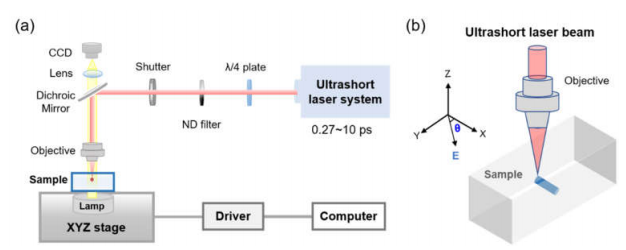In a paper entitled “Polarization-insensitive space-selective etching in fused silica induced by picosecond laser irradiation,” a group of researchers discusses space selective chemical etching, which can be achieved when fused silica is irradiated with focused femtosecond laser beams. Femtosecond lasers are a valuable tool for creating 3D microstructures in transparent materials, including glass. The technique has been used for fabricating various microfluidic devices and optical components.
In their experiments, the researchers used fused silica glass samples as processing substrates. An ultrashort laser system was used for laser direct writing.
“To evaluate the dependence of the etching rate on various combinations of pulse duration, polarization and laser power, we scanned groups of lines (each group contains five parallel lines) with a length of 10 mm and a line spacing of 50 μm under the different conditions,” the researchers state. “The five lines in each group were written under the same condition, and the measurements were performed by averaging the data obtained from the individual lines in the same group.”
“The influence of pulse durations on the etching rates can be divided into two regimes: 0.27 ps (270fs) ~ 4ps and 4~10 ps. In the regime between 0.27 ps and 4 ps, one can see a strong dependence of the etching rate on the polarization of the laser beam,” the researchers explain. “The etching rates obtained with linearly polarized (R ⊥ , θ=90°) laser beams are significantly higher than that obtained with the circularly polarized laser beams (RΟ, circular) and the linearly polarized (R∥, θ=0°) laser beams. In particular, an etching rate of 766.3±22.2 μm/hour can be obtained with the linearly polarized laser beams (R⊥) at 2ps when the laser power is set at 400 mW (see Figure 1d and Table 1), which is the highest etching rate obtained in our investigation.”
The dependence of etching rate on the writing laser polarization originates from the formation of nanogratings in fused silica under repeated irradiation with ultrashort laser pulses; therefore, the researchers continue, the etching behaviors are dominated by the existence of nanogratings induced by ultrashort laser pulses.
“To conclude, our investigations reveal a new region of interaction of ultrashort laser pulses with fused silica which does not form either smooth modification (i. e., region 1) and nanograting (i.e., region 2) or nanovoid (i.e., region 3) as reported previously,” the researchers conclude. It is shown that the picosecond laser irradiation can produce interconnected nanocracks which are preferentially oriented along the laser scan direction. The revealed characteristic is used for fabricating microfluidic channels along different directions to achieve the high etching rates insensitive to the writing laser polarization state.”
The manufacturing of microfluidic channels is complex. Currently, it often involves a lot of manual labor, fusing several different parts or a chain of technologies working together. Although early stage this picosecond approach may lead to a viable commercial technology in manufacturing microfluidics.
Authors of the paper include Xiaolong Li, Jian Xu, Zijie Lin, Jia Qi, Peng Wang, Wei Chu, Zhiwei Fang, Zhenhua Wang, Zhifang Chai and Ya Cheng.
Discuss this and other 3D printing topics at 3DPrintBoard.com or share your thoughts below.
